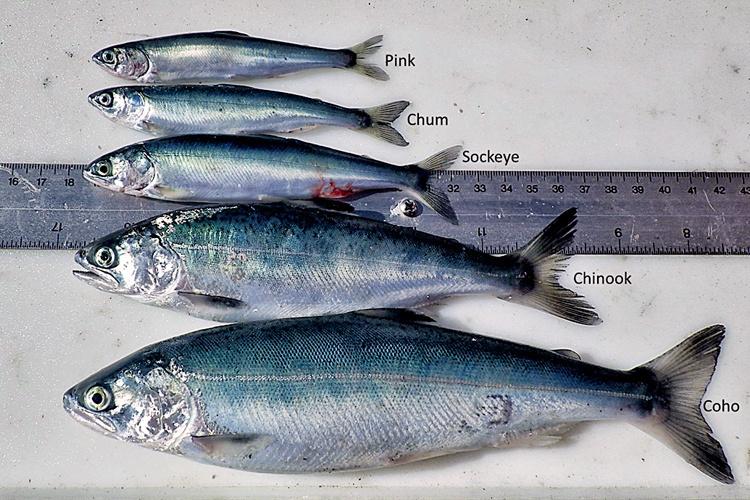Bycatch Dynamics
Salmon are caught incidentally as bycatch in commercial fisheries that target other species. This can impact salmon fisheries and non-salmon fisheries as high bycatches can affect salmon populations and lead to early fishery closures. Preventing and reducing bycatch is a shared goal of fisheries managers, fishermen, and the environmental community. We study salmon bycatch dynamics to enhance these efforts.
Genetic stock identification of the salmon bycatch from commercial trawl fisheries in the Bering Sea and Gulf of Alaska is completed each year to determine which salmon stocks are most affected by the fisheries. Stock composition reports are completed annually by the Alaska Fisheries Science Center’s Genetics Program for chum and Chinook salmon in the Bering Sea and Gulf of Alaska.
Through collaboration with Auke Bay Laboratories’ Ecosystem Monitoring and Analysis Program, this information is now being combined with age composition of salmon bycatch from the Alaska pollock fishery. We are also exploring how bycatch of salmon of different ages and from genetically different stocks varies seasonally and spatially across the Bering Sea and the Gulf of Alaska. This information helps scientists and managers to more precisely estimate the impacts of incidentally caught salmon in federally-managed groundfish fisheries and to better understand how these catches are influenced by environmental changes.
Pacific Salmon Treaty Support
Salmon don’t recognize international borders. We conduct research that supports the Pacific Salmon Treaty, an agreement between the U.S. and Canada to cooperate in the research and management of Pacific salmon stocks that concern both nations:
- Using genetic analysis to identify stock origins and numbers of Canada-bound sockeye salmon caught in the U.S. fishery
- Analyzing the out-migration patterns of western Alaska juvenile chum and Chinook salmon
- Studying how juvenile salmon respond to environmental changes in coastal Southeast Alaska
- Tracking Chinook salmon returns at the Little Port Walter Research Station
- Long-term monitoring of all five Pacific salmon species at Auke Creek Research Station
Forecasting Salmon Returns

NOAA Fisheries, Alaska Department of Fish and Game, and University biologists sort through a trawl catch to identify all fish species present.
We forecast how many adult pink (Southeast Alaska) and Chinook (Yukon River) salmon will be available to harvest by monitoring juvenile salmon and studying how they are affected by climate, prey abundance, and predators.
Our pink salmon forecast in Southeast Alaska has been within 10% of actual harvests in most years. This forecast is used by the Alaska Department of Fish and Game, seafood processors, and local fishermen for pre-season planning.
Up to 90% of Alaskan subsistence harvest of Chinook salmon occurs in the Arctic-Yukon-Kuskokwim region. Recent declines in Chinook salmon returns in the region have resulted in complete closures of commercial and sport fishing, and severely restricted subsistence harvests. A team of NOAA and Alaska Department of Fish and Game biologists have used data from marine surveys to accurately predict run size of Yukon River Chinook salmon up to three years into the future. This work enables managers and subsistence fishermen to plan ahead for and better respond to changing run sizes.
Growth and Survival of Juvenile Salmon
We collect long-term oceanographic and biological data to understand how environmental changes affect juveniles of all five species of Pacific salmon in the Bering Sea and Gulf of Alaska. Our catch and oceanographic data are available on the Alaska Ocean Observing System website.
Marine Survival
A salmon’s first year at sea is the most critical for its survival to adulthood. We observe changes in salmon survival, age structure, and size to establish long-term patterns of marine survival. All salmon raised at NOAA Fisheries’ Little Port Walter Research Station and all native coho salmon smolts encountered at the Auke Creek Research Station fish weir are tagged when released. When they return or are caught in fisheries, tags and data are collected. We use innovative technologies such as acoustic telemetry (using sound-emitting tags to track fish) and autonomous underwater robots to find out where salmon go when they enter the marine environment.
Long-term Monitoring
Our time series of biological and environmental observations provide first-hand evidence of changes in salmon populations in response to climate change. The long-term observations of seven anadromous fish species made at the Auke Creek Research Station are not available anywhere else in Alaska. This information is used by the Alaska Department of Fish and Game to guide harvest management decisions on commercial and recreational fisheries in the region.
Ecosystem Assessment
We track changes in the environment and their impact on fish populations and communities that depend on them. We are currently assessing the vulnerability of salmon to climate change in the Bering Sea. NOAA Fisheries scientists are developing time- and cost-efficient technology to automate the collection of environmental data needed to make these assessments.
Our research findings are contributed to the Alaska Marine Ecosystem Status report, which summarizes and synthesizes historical and possible future effects of climate and fishing on large marine ecosystems. The data we collect are used to develop ecosystem indicators to help predict year class strength of salmon and other fish.
More Info
Alaska boasts nine native species of anadromous (marine fishes that migrate into fresh water to spawn) salmonids. Five salmon species support commercial fisheries: pink [Oncorhynchus gorbuscha], chum [O. keta], sockeye [O.nerka], coho [O. kisutch], and Chinook [O. tshawytscha]). Four are popular targets for recreational fishing: Arctic char [Salvelinus alpinus], Dolly Varden [S. malma], steelhead [O. mykiss], and cutthroat trout [O. clarkii]. All five Pacific salmon as well as Dolly Varden and Arctic char are important subsistence resources.


